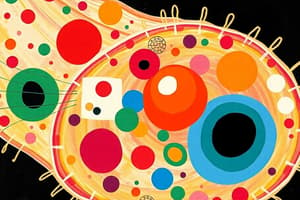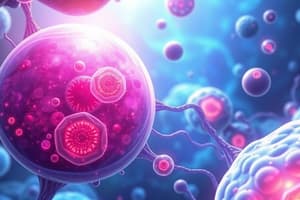Podcast
Questions and Answers
What is the primary function of the Golgi apparatus in the cell?
What is the primary function of the Golgi apparatus in the cell?
- To package and modify proteins (correct)
- To synthesize mRNA from DNA
- To transport substances across the cell membrane
- To produce ATP from glucose
Which organelle is primarily involved in energy production within the cell?
Which organelle is primarily involved in energy production within the cell?
- Lysosomes
- Ribosomes
- Chloroplasts
- Mitochondria (correct)
Which of these organelles is responsible for digesting macromolecules?
Which of these organelles is responsible for digesting macromolecules?
- Smooth ER
- Nucleus
- Lysosomes (correct)
- Chloroplasts
What function do ribosomes serve in the cell?
What function do ribosomes serve in the cell?
How do mitochondria and chloroplasts share a similar characteristic?
How do mitochondria and chloroplasts share a similar characteristic?
What role does the cytoskeleton play in relation to organelles?
What role does the cytoskeleton play in relation to organelles?
What is the primary function of mitochondria within the cell?
What is the primary function of mitochondria within the cell?
Which organelle is primarily responsible for modifying and packaging proteins?
Which organelle is primarily responsible for modifying and packaging proteins?
Which type of organelles are ribosomes classified as?
Which type of organelles are ribosomes classified as?
What feature distinguishes the rough endoplasmic reticulum from the smooth endoplasmic reticulum?
What feature distinguishes the rough endoplasmic reticulum from the smooth endoplasmic reticulum?
What structural characteristic is unique to mitochondria compared to other organelles?
What structural characteristic is unique to mitochondria compared to other organelles?
Which organelle plays a crucial role in photosynthesis?
Which organelle plays a crucial role in photosynthesis?
What is the role of lysosomes in the cell?
What is the role of lysosomes in the cell?
Which organelle is involved in lipid synthesis and detoxification?
Which organelle is involved in lipid synthesis and detoxification?
Flashcards are hidden until you start studying
Study Notes
Function Of Organelles
- Nucleus: Control center of the cell; stores genetic information and coordinates activities like growth and reproduction.
- Mitochondria: Powerhouse of the cell; responsible for energy (ATP) production through cellular respiration.
- Ribosomes: Sites of protein synthesis; can be free in the cytoplasm or bound to the endoplasmic reticulum.
- Endoplasmic Reticulum (ER):
- Rough ER: Studded with ribosomes; synthesizes proteins for export or membrane incorporation.
- Smooth ER: Lacks ribosomes; involved in lipid synthesis and detoxification.
- Golgi Apparatus: Modifies, sorts, and packages proteins and lipids for secretion or delivery to other organelles.
- Lysosomes: Contain digestive enzymes; break down waste materials and cellular debris.
- Chloroplasts (in plants): Sites of photosynthesis; convert solar energy into chemical energy (glucose).
Types Of Organelles
- Membrane-bound Organelles: Surrounded by lipid membranes (e.g., nucleus, mitochondria, ER, Golgi apparatus, lysosomes, chloroplasts).
- Non-membrane-bound Organelles: Not enclosed by membranes (e.g., ribosomes, cytoskeleton).
Organelle Structure
- Nucleus: Double membrane (nuclear envelope) with nuclear pores; contains chromatin and nucleolus.
- Mitochondria: Double membrane; inner membrane is folded into cristae; contains its own DNA.
- Ribosomes: Composed of rRNA and proteins; consist of two subunits (large and small).
- ER: Network of membranous tubules and sacs; continuous with the nuclear envelope.
- Golgi Apparatus: Stacked, flattened membranous sacs (cisternae); has cis and trans faces for processing.
- Lysosomes: Membrane-bound vesicles containing hydrolytic enzymes; acidic interior for digestion.
- Chloroplasts: Double membrane; contain thylakoids organized into stacks (grana) and stroma with DNA.
Cellular Processes Involving Organelles
- Protein Synthesis: Ribosomes translate mRNA into proteins; Rough ER modifies proteins; Golgi apparatus packages them.
- Energy Production: Mitochondria conduct cellular respiration; convert glucose to ATP.
- Photosynthesis: Chloroplasts convert light energy to chemical energy; produce glucose and oxygen from carbon dioxide and water.
- Digestion and Waste Processing: Lysosomes digest macromolecules; recycle cellular components.
Organelle Interactions
- Nucleus and Ribosomes: Nucleus synthesizes mRNA; ribosomes use mRNA to build proteins.
- ER and Golgi Apparatus: Proteins synthesized in the ER are transported to Golgi for modification and sorting.
- Mitochondria and Chloroplasts: Both organelles have their own DNA; involved in energy transformation processes.
- Lysosomes and Other Organelles: Lysosomes fuse with vesicles containing cellular debris or pathogens for degradation.
- Cytoskeleton and Organelles: Cytoskeleton provides structural support; aids in the transport of organelles within the cell.
Function of Organelles
- Nucleus: Acts as the cell's control center; responsible for storing genetic information and managing cellular functions such as growth and reproduction.
- Mitochondria: Known as the powerhouses of the cell; essential for ATP production via cellular respiration, converting nutrients into usable energy.
- Ribosomes: Function as sites for protein synthesis; can exist freely in the cytoplasm or be attached to the endoplasmic reticulum, indicating varying roles in protein production.
- Endoplasmic Reticulum (ER):
- Rough ER: Characterized by ribosome presence; primarily synthesizes proteins intended for export outside the cell or for insertion into membranes.
- Smooth ER: Lacks ribosomes; focuses on lipid synthesis and detoxifying harmful metabolic byproducts.
- Golgi Apparatus: Serves as a hub for modifying, sorting, and packaging proteins and lipids for secretion or distribution to other organelles.
- Lysosomes: Contain hydrolytic enzymes that digest waste materials and recycle cellular debris, playing a crucial role in cellular cleanup.
- Chloroplasts: Found in plant cells; are the sites of photosynthesis, transforming solar energy into chemical energy in the form of glucose.
Types of Organelles
- Membrane-bound Organelles: Enclosed by lipid membranes, including the nucleus, mitochondria, endoplasmic reticulum, Golgi apparatus, lysosomes, and chloroplasts.
- Non-membrane-bound Organelles: Not encapsulated by membranes; primarily ribosomes and the cytoskeleton.
Organelle Structure
- Nucleus: Enclosed by a double membrane known as the nuclear envelope, which features nuclear pores; contains chromatin and a nucleolus.
- Mitochondria: Composed of a double membrane, with the inner membrane folded into structures called cristae; contains its own genetic material.
- Ribosomes: Made up of ribosomal RNA (rRNA) and proteins; form two subunits (large and small) crucial for their protein synthesis role.
- ER: Formed by a network of membranous tubules and sacs that are interconnected and continuous with the nuclear envelope.
- Golgi Apparatus: Comprises stacked, flattened membrane sacs called cisternae, with distinct cis and trans faces facilitating protein processing.
- Lysosomes: Vesicles that are membrane-bound and contain hydrolytic enzymes; operate best in an acidic environment conducive for digestion.
- Chloroplasts: Surrounded by a double membrane; contain thylakoids stacked into grana and stroma, also housing their own DNA.
Cellular Processes Involving Organelles
- Protein Synthesis: Involves ribosomes translating mRNA into proteins, with subsequent modification in the Rough ER and packaging in the Golgi apparatus for delivery.
- Energy Production: Mitochondria engage in cellular respiration, converting glucose into ATP, essential for cellular energy needs.
- Photosynthesis: Occurs in chloroplasts, where light energy is transformed into chemical energy, producing glucose and oxygen from carbon dioxide and water.
- Digestion and Waste Processing: Lysosomes digest macromolecules and recycle cellular components, maintaining cellular homeostasis.
Organelle Interactions
- Nucleus and Ribosomes: The nucleus produces mRNA, which is transported to ribosomes for protein synthesis.
- ER and Golgi Apparatus: Following protein synthesis in the ER, proteins are sent to the Golgi apparatus for further modification and sorting.
- Mitochondria and Chloroplasts: Both possess their own DNA and play key roles in energy transformation processes within the cell.
- Lysosomes and Other Organelles: Lysosomes can fuse with vesicles to degrade cellular debris or pathogens, ensuring cellular integrity.
- Cytoskeleton and Organelles: The cytoskeleton offers structural support and facilitates organelle transport, maintaining cellular organization.
Studying That Suits You
Use AI to generate personalized quizzes and flashcards to suit your learning preferences.




